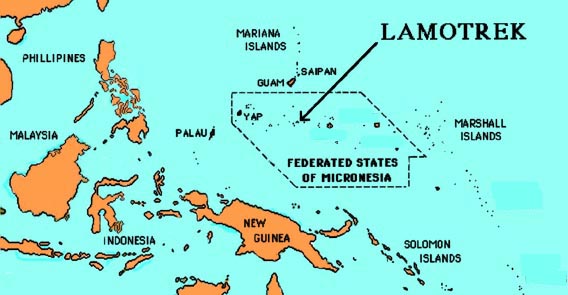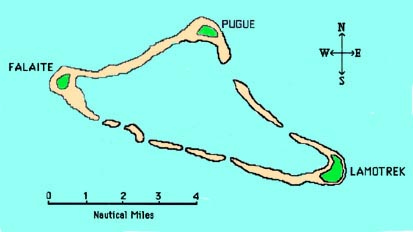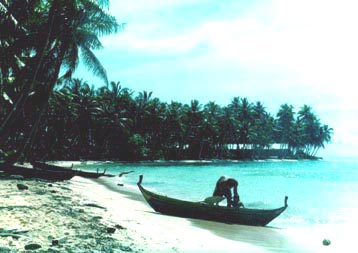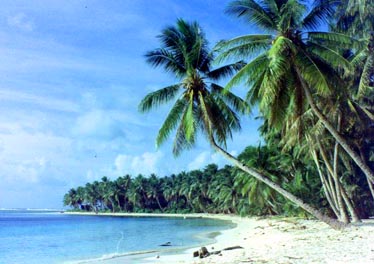
Map 1. Western Pacific Ocean

Lamotrek Island is one of three islands that make up the low coral atoll of Lamotrek, the other two islands, Pugue and Falaite, are presently uninhabited though it is believed that people lived on them at the time of the first recorded discovery of Lamotrek in 1797 by Captain James Wilson in the ship "Duff."

Politically and geographically, Lamotrek Atoll belongs to Yap State in the Caroline Islands of the Federated States of Micronesia (see Map 1 above), but linguistic and cultural evidence indicates that Lamotrek was settled not from the West but from the East. There is linguistic evidence, for instance, that suggests movement into what is now Micronesia from the islands associated with the Lapita culture southeast of the Solomon Islands in what is now Western Polynesia starting around 1000 B.C. Archaeological evidence, however, suggests that the region surrounding Lamotrek may have been initially settled from the West (possibly Yap or Guam) by migrants using calcareous, sand-tempered pottery, prior to or around the beginning of the Christian era. It is probable that central Micronesia, including Lamotrek, may have been settled from more than one direction and during more than one time period over several millennia. The time periods and patterns of migration through this area of the world remains a matter of debate among scientists. Nevertheless, the ever-increasing linguistic, cultural, and archaeological evidence supports a southern migration route theory for the indigenous population living on Lamotrek today, with settlement taking place by 1100 A.D. and perhaps as early as 300 A.D.
Lamotrek Island: Looking South
Lamotrek Island, which averages no more than three to four feet above sea level, has a total population of around 350 people. The population is reduced to around 300 persons nine months out of the year when students leave to go Woleai Atoll, located about 300 miles to the West, to attend the nearest outer island high school, and others travel to attend the high school on Ulithi Atoll, some 300 miles further. A number of individuals regularly travel on the inter-island service ship to Yap, another 100 miles from Ulithi, to seek health care, employment, modern attractions such as television, alternate lifestyles, and consumer goods. Return ship service to Lamotrek is irregular and uncertain, averaging about four to six contacts in the course of a year. The main exports are dried coconut meat, traditional woven textiles and coconut fiber sennit.

Lamotrek Island: Looking North
Along with the rest of the islands in Micronesia, Lamotrek islanders began being influenced by Europeans after 1521, the year Ferdinand Magellan landed on Guam. This discovery, the first in Oceania, resulted in several centuries of Spanish domination. When the Spanish-American war ended in 1898, most of Micronesia, including Lamotrek was sold to Germany for $6,000,000. In 1914, at the beginning of World War I, Japan took control of all the islands in Micronesia with the exception of Guam which was being used by the United States as a naval base. At the end of World War II, the United states captured the islands held by Japan, and in 1947 Micronesia was declared a Trust Territory of the Pacific Islands to be administered by the United States under a charter from the United Nations. The terms of the Trusteeship Agreement gave the United States full administrative and legal authority as well as military powers. It also required the United States to, among other things, promote the social, economic, and educational advancement of the population. In 1979, Lamotrek along with the island states of Yap, Truk (now called Chuuk), Ponape (now Pohnpei), and Kusaie ( now Kosrae) became self-governing as the Federated States of Micronesia. In 1983, the Federated States of Micronesia voted in favor of a status that would grant them internal political autonomy from the United States while guaranteeing annual financial assistance from the United States in exchange for defense rights. This relationship is referred to as the Compact of Free Association between the United States and the Federated States of Micronesia. In theory, the Federated States of Micronesia along with two other Micronesian nations, the Republic of Belau and Republic of Marshall Islands, will become economically independent nations. Guam will remain a United States Territory and the Northern Mariana Islands a United States Commonwealth.